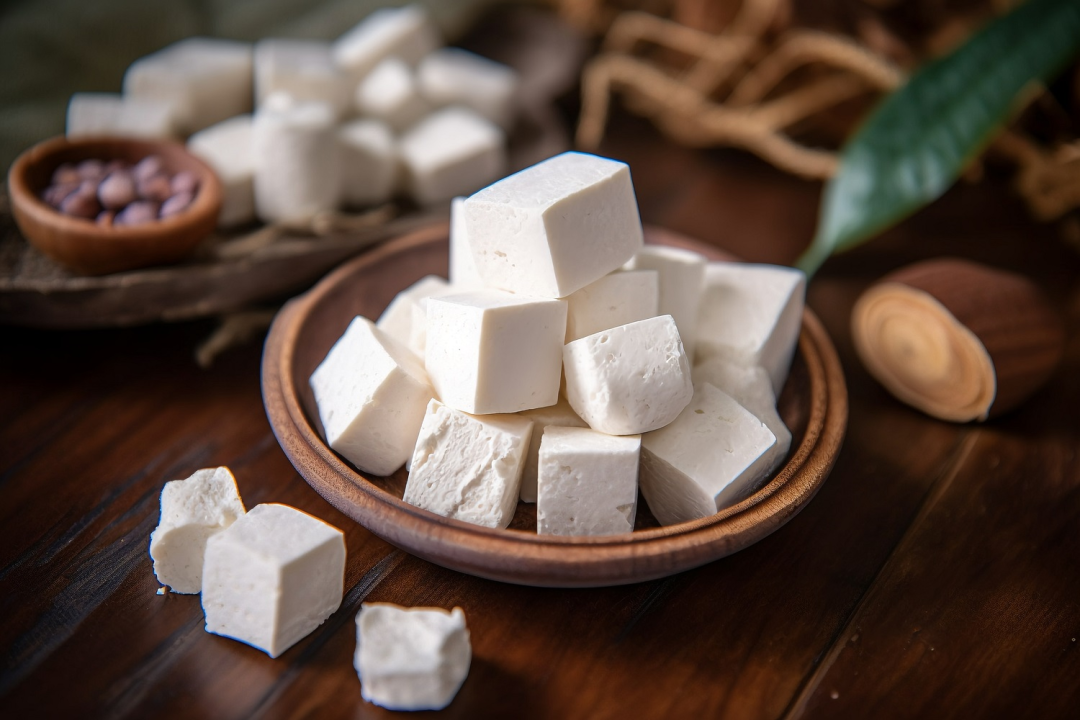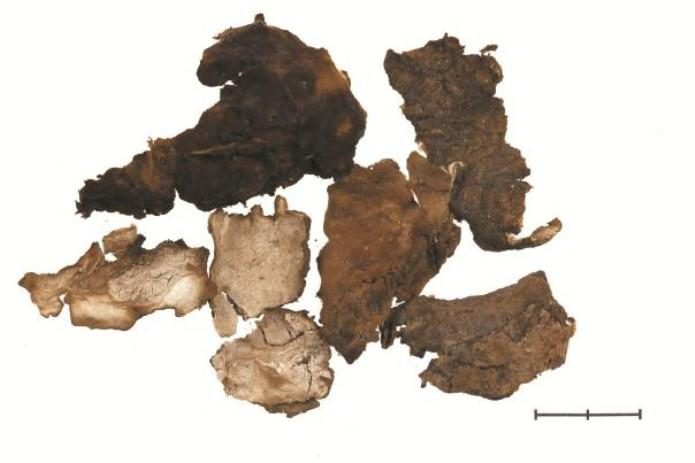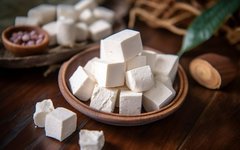Editor’s Note
Fu Ling (Poria) is a large family, which includes Bai Fu Ling (White Poria), Chi Fu Ling (Red Poria), Fu Shen (Poria Sclerotium), and Fu Ling Pi (Poria Skin). Fu Ling is a type of fungal sclerotium that generally grows by parasitizing the roots of pine trees. It has been recorded in the “Huai Nan Zi” over 2000 years ago, stating “the thousand-year-old pine has Fu Ling beneath it.” During its growth, Bai Fu Ling, Chi Fu Ling, Fu Shen, and Fu Ling Pi successively emerge. Although they are all derived from the same source, they each have unique characteristics, with differences in appearance and efficacy. Let’s explore them together.
 Fu Ling was first recorded in the “Shen Nong Ben Cao Jing” as a superior herb, believed to “calm the soul and nourish the spirit, prolong life without hunger” when taken over a long period. Fu Ling has a sweet and bland taste, and a neutral nature, which can promote urination, strengthen the spleen, calm the mind, and can be used for symptoms such as edema, reduced urination, phlegm, dizziness, spleen deficiency, poor appetite, diarrhea, anxiety, and insomnia.Fu Ling is a type of fungal sclerotium that generally grows by parasitizing the roots of pine trees. Fresh Fu Ling resembles sweet potatoes, with some being spherical or block-like, while others are flat and oval-shaped, with a rough surface covered in small lumps or wrinkles.
Fu Ling was first recorded in the “Shen Nong Ben Cao Jing” as a superior herb, believed to “calm the soul and nourish the spirit, prolong life without hunger” when taken over a long period. Fu Ling has a sweet and bland taste, and a neutral nature, which can promote urination, strengthen the spleen, calm the mind, and can be used for symptoms such as edema, reduced urination, phlegm, dizziness, spleen deficiency, poor appetite, diarrhea, anxiety, and insomnia.Fu Ling is a type of fungal sclerotium that generally grows by parasitizing the roots of pine trees. Fresh Fu Ling resembles sweet potatoes, with some being spherical or block-like, while others are flat and oval-shaped, with a rough surface covered in small lumps or wrinkles.
Bai Fu Ling, Chi Fu Ling, Fu Shen, and Fu Ling Pi all come from the same plant, Fu Ling. The outer skin is mostly brown, with the inner layers being brown Fu Ling Pi, light red Chi Fu Ling, milky white Bai Fu Ling, and gray Fu Shen. Although they originate from the same plant, their effects are slightly different. The Fu Ling produced in Yunnan is of the highest quality and is known as Yun Ling, a genuine medicinal material.
 Bai Fu Ling
Bai Fu Ling
is what is clinically referred to as Fu Ling. Bai Fu Ling is the white part of Fu Ling, often cut into small white cubes for medicinal use. This herb has a sweet and bland taste and a neutral nature, entering the heart, spleen, and stomach meridians. Its sweetness can tonify, its blandness can drain dampness, and its sweetness can nourish the spleen and heart. Its strong draining ability can promote urination and eliminate dampness. Therefore,Bai Fu Ling has the characteristics of tonifying without being harsh, draining without being forceful, supporting the righteous while expelling the evil, which is why it has been referred to as an excellent herb for “tonifying and draining dampness,” beneficial for promoting urination, strengthening the spleen, and calming the heart and spirit.
1. Bai Fu Ling and Job’s Tears Porridge. 15 grams of Bai Fu Ling and 60 grams of Job’s Tears. Grind into a fine powder, place in a pot, add an appropriate amount of water, and cook until done. It has the effect of clearing heat and regulating spleen dampness. Suitable for those with cough and excessive phlegm, chest fullness, or rheumatic joint swelling and pain.
2. Lotus Seed and Bai Fu Ling Cake. Equal parts of Bai Fu Ling, lotus seeds, and Ophiopogon, ground into powder, mixed with an appropriate amount of sugar and osmanthus, and steamed into a cake. It has the effect of calming the heart and strengthening the spleen. Suitable for those with insufficient heart yin and weak spleen qi leading to thirst, palpitations, anxiety, poor appetite, and fatigue. This method of consuming Bai Fu Ling can effectively strengthen the spleen and stomach and alleviate symptoms of spleen and stomach deficiency, as well as help relieve fatigue and palpitations.
3. Bai Fu Ling Paste. 500 grams of Bai Fu Ling and 1000 grams of honey. Grind Bai Fu Ling into a fine powder, mix with honey evenly, and simmer over low heat until it becomes a paste. Cool and store in a porcelain jar. Take 10 grams with warm water, twice a day. It can strengthen the spleen, drain dampness, and aid in weight loss. Suitable for preventing senile edema and obesity. Bai Fu Ling can aid in weight loss.
4. Bai Fu Ling Wine. 60 grams of Bai Fu Ling and 500 grams of white liquor. Soak Bai Fu Ling in the liquor for 7 days before drinking. It can drain dampness, strengthen muscles, calm the heart, and soothe the spirit. Suitable for those with muscle numbness in the limbs, palpitations, and insomnia.
 Chi Fu Ling
Chi Fu Ling
Chi Fu Ling is the red part of Fu Ling Pi (the outer rough skin removed), which is the internal light red part of Fu Ling. Its taste and properties are similar to Fu Ling, but it is more inclined to enter the blood aspect, without tonifying effects, and is better at draining damp heat and promoting urination. It is often used to treat urinary difficulties, painful urination, and other symptoms caused by damp heat in the lower jiao, commonly used with Che Qian Zi (Plantago Seed), Hua Shi (Talc), and Gan Cao (Licorice), such as in the Wu Lin San formula.
 Fu Ling Pi
Fu Ling Pi Fu Ling Pi Source: “Illustrated Guide to Chinese Medicinal Herbs”
Fu Ling Pi Source: “Illustrated Guide to Chinese Medicinal Herbs”
is the outer cortical part of Fu Ling, with properties similar to Fu Ling, but is more inclined to the surface, functioning to promote urination and reduce swelling. Ancient texts state that Fu Ling Pi specifically treats skin edema, hence the saying “to treat skin with skin.” The “Encyclopedia of Chinese Medicine” states: “Fu Ling promotes water without depleting qi, superior to Da Fu Pi (Trichosanthes Fruit Skin).” Fu Ling Pi treats edema due to spleen deficiency that cannot promote water, leading to generalized swelling, as well as edema during pregnancy, and is often combined with Da Fu Pi, Chen Pi (Aged Tangerine Peel), and Jiang Pi (Ginger Peel), as in the Wu Pi Yin formula. Fu Ling that is not peeled is called Bai Pi Fu Ling, primarily used for water retention, generally suitable for more severe edema symptoms.
As for Tu Fu Ling, it is a different plant and has no relation to Fu Ling. Although it resembles Fu Ling, its effects are entirely different. Tu Fu Ling is a vine plant, with leaves resembling bamboo leaves but thicker and smoother, and its roots grow in clusters, large as duck eggs, with a sweet, bland, and neutral nature, having the effects of clearing heat, detoxifying, strengthening the spleen, and eliminating dampness.
 Fu Shen
Fu Shen
is the part of Fu Ling that grows around the roots of pine trees, also known as Fu Shen Mu (Fu Shen Wood), or Bao Mu Fu Shen (Wood-Encircling Fu Shen). According to the “Ben Cao Jing Shu”: “Fu Shen grows around the heart of the wood, distinguishing it from Fu Ling. The “Bie Lu” states that Fu Shen is neutral, and its taste and properties correspond to Fu Ling – it is primarily used for the spleen and kidney, while Fu Shen is more often used for the heart.” Fu Shen has similar properties to Fu Ling, but is more inclined to the heart meridian, excelling at calming the heart and soothing the spirit, primarily treating symptoms such as palpitations, anxiety, insomnia, and forgetfulness caused by heart deficiency or both heart and spleen deficiency, often used with Suan Zao Ren (Sour Jujube Seed) and other calming herbs. When combined with Zhu Sha (Cinnabar), it is known as Zhu Sha Fu Shen, which has a stronger calming and stabilizing effect.

